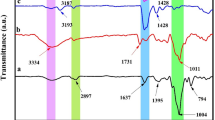Abstract
As a liquid fertilizer slow-release material, carboxymethylcellulose-based superabsorbents having biodegradable properties have recently attracted attention. To improve the gel properties of this superabsorbent, which has relatively low mechanical strength, additive materials such as graphite oxide (GO), reduced graphene oxide (rGO), activated carbon, and bentonite were used in this work. While preparing composite superabsorbents using electron beam (EB) radiation, effects of the type and composition of additives, absorbed dose of EB, and type of radiation on the properties of the prepared materials were investigated. In addition, it was attempted to find the optimum synthesis conditions for the preparation of composite superabsorbents. Gel strength and gel fraction were measured to determine the intermolecular binding force of the prepared composite superabsorbents. Swelling tests were carried out in distilled water, urea aqueous solution and NaCl aqueous solution, respectively, to determine the equilibrium swelling ratio and swelling rate in various environments. To examine the applicability of the prepared superabsorents in the field, elution tests were performed using urea as a simulated nitrogen fertilizer. Plant growth experiments were also carried out with spinach and crown daisy to confirm the applicability of the prepared superabsorbents for agricultural purpose. Super-absorbents with GO and rGO showed high gel fraction and high mechanical strength due to the high intermolecular binding force between polymer gel and carbon additive material. In the composite superabsorbents with GO and rGO, gel strength and gel fraction increased with the increase of the amount of inorganic additives, but the equilibrium swelling ratio decreased. Superabsorbents prepared by irradiation of EB at 10 kGy exhibited the highest equilibrium swelling ratio, and the equilibrium swelling ratio decreased as the absorbed dose increased. Furthermore, composite superabsorbents prepared by EB irradiation showed higher gel strength than those prepared by γ-ray irradiation. Plant growth was better in the experimental group containing the superabsorbent and the liquid fertilizer, indicating that the prepared composite superabsorbent could function as a slow-release liquid fertilizer.
Similar content being viewed by others
References
1996 Protocol to the Convention on the Prevention of Marine Pollution by Dumping of Wastes and Other Matter (as amended in 2006).
National Institute of Animal Science Korea, Liquefaction of livestock manure. http://www.nias.gok/enWDataFileDown.do?fileid=14004, 2008 (accessed 1 November 2016).
M. J. Zohuriaan-Mehr and K. Kabiri, Iran. Polym. J., 17, 451 (2008).
C. Chang, B. Duan, J. Cai and L. Zhang, Eur. Polym. J., 46, 92 (2010).
S. Francis, D. Mitra, B. R. Dhanawade, L. Varshney and S. Sabharwal, Radiat. Phys. Chem, 78, 951 (2009).
R. L. Clough, Nucl. Instrum. Methods Phys. Res. Sect. B-Beam Interact. Mater. Atoms, 185, 8 (2001).
K. Kabiri, H. Omidian, M. J. Zohuriaan-Mehr and S. Doroudiani, Polym. Compos., 32, 277 (2011).
B. Fei, R.A. Wach, H. Mitomo, F. Yoshii and T. Kume J. Appl. Polym. Sci., 78, 278 (2000).
R. A. Wach, H. Mitomo, F. Yoshii and T. Kume, J. Appl. Polym. Sci., 81, 3030 (2001).
J. Qiu, L. Xu, J. Peng, M. Zhai, L. Zhao, J. Li and G. Wei, Carbohydr. Polym, 70, 236 (2007).
J. Kwon and B. Lee, Chem. Eng. Res. Des., 104, 519 (2015).
Y. Tang, H. Tang, F. Wang, C. Guan and L. Zhu, Polym. Sci. Ser. B, 61, 471 (2019).
L. Zhu, Y. Liu, B. Zhou, H. Tang, F. Wang and C. Guan, Polym. Sci. Ser. B, 61, 680 (2019).
L. Zhu, Y. Liu, F. Wang, T. He, Y. Tang and J. Yang, Adv. Polym. Technol., 37, 2885 (2018).
Y Sung, T.-H. Kim and B. Lee, Macromol. Res., 24, 143 (2016).
Y Sung, T.-H. Kim and B. Lee, Clean Technol., 22, 258 (2016).
D. R. Dreyer, S. Park, C. W. Bielawski and R. S. Ruoff, Chem. Soc. Rev., 39, 228 (2010).
D. C. Marcano, D. V. Kosynkin, J. M. Berlin, A. Sinitskii, Z. Sun, A. Slesarev, L. B. Alemany, W. Lu and J. M. Tour, ACS Nano, 4, 4806 (2010).
Y Huang, M. Zeng, J. Ren, J. Wang, L. Fan and Q. Xu, Colloid Surf. A-Physicochem. Eng. Asp., 401, 97 (2012).
I. Katime, A. Álvarez-Bautista, L. G. Guerrero-Ramírez and E. Mendizábal, Topol. Supramol. Polym. Sci., 1, 17 (2014).
J.-T. Han, S.-Y. Jeong, H.-J. Jeong and G.-W. Lee, Polym. Sci. Technol., 22, 137 (2011).
J.-S. Lee, B.-A. Kim and C.-K. Moon, J. Korean Soc. Power Syst. Eng., 18, 7 (2014).
Y Seki, A. Altinisik, B. Demircioglu and C. Tetik, Cellulose, 21, 1689 (2014).
S. G. A. Alla, M. Sen and A. W. M. El-Naggar, Carbohydr. Polym., 89, 478 (2012).
K. M. El Salmawi and S. M. Ibrahim, Macromol. Res., 19, 1029 (2011).
Acknowledgement
This research was supported by the Bisa Research Grant of Keimyung University in 2019.
Author information
Authors and Affiliations
Corresponding author
Electronic supplementary material
Rights and permissions
About this article
Cite this article
Kim, B., Kim, TH. & Lee, B. Optimal synthesis of carboxymethylcellulose-based composite superabsorbents. Korean J. Chem. Eng. 38, 215–225 (2021). https://doi.org/10.1007/s11814-020-0681-4
Received:
Revised:
Accepted:
Published:
Issue Date:
DOI: https://doi.org/10.1007/s11814-020-0681-4




